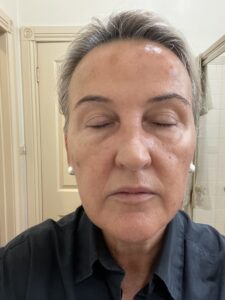Hyperpigmentation refers to an excess of pigment in the skin, causing it to appear darker than the surrounding skin. This can be caused by various factors such as sun exposure, hormonal changes, and inflammation.
Hypopigmentation, on the other hand, refers to a loss of pigment in the skin, causing it to appear lighter than the surrounding skin. This can be caused by various factors such as genetic conditions, skin damage, and certain medical treatments.
In summary, hyperpigmentation is an excess of pigment causing darkening of the skin, while hypopigmentation is a loss of pigment causing a lightening of the skin.
(Before & After)


What is Hyperpigmentation?
Hyperpigmentation is an excess production of melanin in a particular area and can include freckles, sunspots (sometimes called liver spots) melasma and post inflammatory pigment spots. It is usually unwanted and can look unsightly unlike a suntan that is even and desired and will fade once out of the sun.
What is Post Inflammatory Hyperpigmentation?
Post-inflammatory hyperpigmentation (PIH) is a type of hyperpigmentation that occurs as a result of inflammation or injury to the skin. It is a common condition that can affect people of all skin types but is more common in individuals with darker skin tones.
PIH occurs when the skin produces an excess of melanin in response to inflammation or injury. This excess melanin can cause dark spots or patches on the skin that can last for weeks or months after the initial injury or inflammation has healed.
Common causes of PIH include acne, eczema, psoriasis, insect bites, and burns. Treatment options for PIH include topical creams, chemical peels, and laser therapy. It is important to protect the skin from further damage by using sunscreen and avoiding exposure to UV rays.
What Causes Hyperpigmentation?
Hyperpigmentation can be caused by a variety of factors, including:
1. Sun exposure: Exposure to UV rays from the sun can cause an increase in melanin production, leading to hyperpigmentation.
2. Hormonal changes: Hormonal changes during pregnancy, menopause, or while taking birth control pills can cause hyperpigmentation.
3. Inflammation: Inflammatory skin conditions such as acne, eczema, and psoriasis can cause hyperpigmentation.
4. Trauma: Injuries to the skin, such as cuts, burns, and bruises, can cause hyperpigmentation.
5. Genetics: Some people may be more prone to hyperpigmentation due to their genetic makeup.
6. Age: As we age, our skin becomes thinner and more susceptible to hyperpigmentation.
7. Certain medications: Some medications, such as chemotherapy drugs and antibiotics, can cause hyperpigmentation as a side effect.
It is important to protect the skin from further damage by using sunscreen and avoiding exposure to UV rays. Treatment options for hyperpigmentation include topical creams, chemical peels, and laser therapy.
Does hyperpigmentation fade?
Hyperpigmentation can fade naturally over time, but the amount of time it takes for the pigmentation to fade can vary depending on the cause and severity of the hyperpigmentation. In some cases, hyperpigmentation may fade within a few weeks or months, while in other cases it may take several months or even years for the pigmentation to fade.
The natural fading process can be accelerated by using topical treatments such as retinoids, vitamin C, and hydroquinone, which can help to reduce the production of melanin and promote skin cell turnover. Chemical peels and laser therapy can also be effective in reducing hyperpigmentation.
It is important to note that hyperpigmentation may not completely fade, especially if it is caused by genetics or a chronic condition. However, with proper treatment and sun protection, the appearance of hyperpigmentation can be significantly reduced.
The best treatments for Hyperpigmentation?
The best treatment for hyperpigmentation depends on the underlying cause and severity of the condition. Here are some of the most effective treatments for hyperpigmentation:
1. Topical treatments: Topical treatments such as hydroquinone, retinoids, and vitamin C can be effective in reducing hyperpigmentation. These treatments work by inhibiting the production of melanin and promoting skin cell turnover.
2. Chemical peels: Chemical peels involve applying a chemical solution to the skin to remove the outer layer of skin cells. This can help to reduce hyperpigmentation and promote skin cell turnover.
3. Laser therapy: Laser therapy involves using a laser to target and destroy the melanin-producing cells in the skin. This can help to reduce hyperpigmentation and promote skin cell turnover.
4. Microdermabrasion: Microdermabrasion involves using a device to exfoliate the outer layer of skin cells. This can help to reduce hyperpigmentation and promote skin cell turnover.
5. Sun protection: Protecting the skin from further damage by using sunscreen and avoiding exposure to UV rays is essential in preventing and reducing hyperpigmentation.
It is important to note that treatment for hyperpigmentation may take time and may not completely eliminate the pigmentation. In addition, it is important to address the underlying cause of the hyperpigmentation to prevent it from recurring.
What is Hypopigmentation?
Hypopigmentation is when the cells stop producing pigmentation. If the cell is being affected by medications or hormones the pigment may come back. If, however the cell has been damaged by sun damage this is often irreversible
What Causes Hypopigmentation?
Hypopigmentation can be caused by a variety of factors, including:
1. Genetic conditions: Some genetic conditions, such as albinism and piebaldism, can cause hypopigmentation.
2. Skin damage: Injuries to the skin, such as burns, cuts, and infections, can damage the melanocytes (cells that produce melanin) and cause hypopigmentation.
3. Autoimmune disorders: Autoimmune disorders such as vitiligo and lupus can cause hypopigmentation.
4. Certain medications: Some medications, such as chemotherapy drugs and antibiotics, can cause hypopigmentation as a side effect.
5. Nutritional deficiencies: Deficiencies in certain nutrients, such as vitamin B12 and folic acid, can cause hypopigmentation.
6. Aging: As we age, our skin produces less melanin, which can cause hypopigmentation.
7. Exposure to chemicals: Exposure to certain chemicals, such as hydroquinone and benzoyl peroxide, can cause hypopigmentation.
Treatment options for hypopigmentation depend on the underlying cause. In some cases, the hypopigmentation may be permanent and cannot be reversed. However, in other cases, topical treatments such as corticosteroids and vitamin D analogues, as well as light therapy, can be effective in restoring skin pigmentation.
Does hypopigmentation go away?
Hypopigmentation may or may not go away, depending on the underlying cause. In some cases, hypopigmentation may be permanent and cannot be reversed. For example, if the hypopigmentation is caused by a genetic condition such as albinism, it is unlikely to go away.
However, in other cases, hypopigmentation may be temporary and can be treated. For example, if the hypopigmentation is caused by skin damage, such as a burn or cut, the skin may gradually regain its pigmentation as it heals. In some cases, topical treatments such as corticosteroids and vitamin D analogues, as well as light therapy, can be effective in restoring skin pigmentation.
It is important to note that treatment for hypopigmentation may take time and may not completely restore the skin’s pigmentation. In addition, it is important to protect the skin from further damage by using sunscreen and avoiding exposure to UV rays.
Treatments for Hypopigmentation
The treatment for hypopigmentation depends on the underlying cause. Here are some of the treatment options:
1. Topical treatments: Topical treatments such as corticosteroids, vitamin D analogues, and tacrolimus can be effective in restoring skin pigmentation. These treatments work by suppressing the immune system and promoting the production of melanin.
2. Light therapy: Light therapy, also known as phototherapy, involves exposing the skin to ultraviolet light. This can help to stimulate the production of melanin and restore skin pigmentation.
3. Microneedling: Microneedling involves using a device with tiny needles to create small punctures in the skin. This can help to stimulate the production of melanin and restore skin pigmentation.
4. Skin grafting: In some cases, skin grafting may be necessary to restore skin pigmentation. This involves taking a small piece of skin from another part of the body and transplanting it to the affected area.
5. Cosmetic camouflage: Cosmetic camouflage involves using makeup or self-tanning products to cover up the hypopigmented areas.
It is important to note that treatment for hypopigmentation may take time and may not completely restore the skin’s pigmentation. In addition, it is important to protect the skin from further damage by using sunscreen and avoiding exposure to UV rays.
AT U SKIN CLINICS WE HAVE A LARGE RANGE OF TREATMENTS FOR BOTH HYPO AND HYPER PIGMENT. BOOK A CONSULTATION SO WE CAN TAILOR A PLAN TO SUIT YOU
Book online at Uskinclinics.com.au or call 93701997

